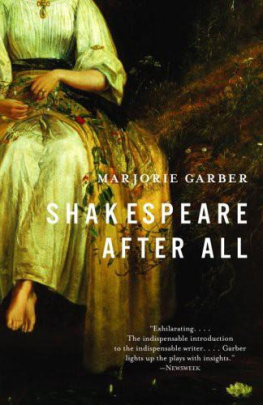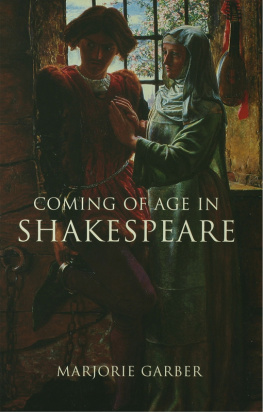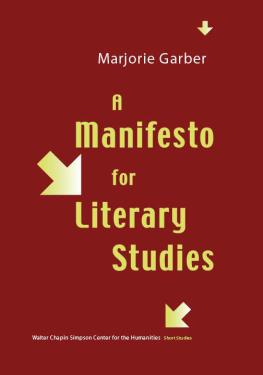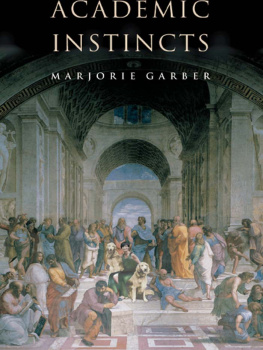THE MUSES ON THEIR LUNCH HOUR
The Muses on Their Lunch Hour
MARJORIE GARBER

Copyright 2017 Marjorie Garber
All rights reserved. No part of this publication may be reproduced, stored in a retrieval system, or transmitted in any form or by any meanselectronic, mechanical, photocopy, recording, or any otherexcept for brief quotations in printed reviews, without the prior permission of the publisher.
Excerpts from Burnt Norton from FOUR QUARTETS by T. S. Eliot. Copyright 1936 by Houghton Mifflin Harcourt Publishing Company; Copyright renewed 1964 by T. S. Eliot. Copyright 1941 by T. S. Eliot; Copyright renewed 1969 by Esme Valerie Eliot. Reprinted by permission of Houghton Mifflin Harcourt Publishing Company. All rights reserved.
Fordham University Press has no responsibility for the persistence or accuracy of URLs for external or third-party Internet websites referred to in this publication and does not guarantee that any content on such websites is, or will remain, accurate or appropriate.
Fordham University Press also publishes its books in a variety of electronic formats. Some content that appears in print may not be available in electronic books.
Visit us online at www.fordhampress.com.
Library of Congress Cataloging-in-Publication Data
Names: Garber, Marjorie B., author.
Title: The Muses on their lunch hour / Marjorie Garber.
Description: First edition. | New York : Fordham University Press, 2017. | Includes bibliographical references and index.
Identifiers: LCCN 2016027233 | ISBN 9780823273720 (hardback) | ISBN 9780823273737 (paper)
Subjects: | BISAC: LITERARY CRITICISM / General. | SOCIAL SCIENCE / Popular Culture. | EDUCATION / Higher.
Classification: LCC AC8.5 .G37 2017 | DDC 814/.54dc23
LC record available at https://lccn.loc.gov/2016027233
Printed in the United States of America
19 18 175 4 3 2 1
First edition
For Helen Tartar
CONTENTS
It is a pleasure to acknowledge the many friends and colleagues who have helped me at various stages of the composition and editing of these essays. Bill Germano was once again a marvelous reader, critic, and co-conspirator in the shaping of individual pieces and of the book as a whole. I owe him not only my warmest thanks but also the best dinner we can find. William Ira Bennett generously read a number of the essays, and made many valuable suggestions that have been incorporated into the text. Jonathan Culler offered essential advice and encouragement at a crucial time. Calista McRae, Sabrina Sadique, and Kailey Bennett provided key editorial assistance at various stages of manuscript preparation. My editor at Fordham University Press, Tom Lay, has been unfailingly helpful and responsive, as have Eric Newman, Nancy Rapoport, and others at Fordham. I thank them for all their interest and attention to detail.
A few essays have been previously published, and I am grateful to the editors of the publications where they first appeared for their excellent comments and meticulous editing: to Tom Mitchell and Jay Williams at Critical Inquiry for Ovid, Now and Then (Critical Inquiry 40, no. 1, Autumn 2013) and Over the Influence (Critical Inquiry 42, no. 4, Summer 2016); Renate Ferro, Mieke Bal, and Michelle Williams Gamaker, the editors of Saying It (London: Occasional Papers, 2012) for Baggage Screening. Asking Literary Questions first appeared in my Manifesto for Literary Studies (Seattle: University of Washington Press, 2003); my thanks to the Simpson Center for the Humanities for permission to reprint it here.
This book is dedicated to the memory of Helen Tartar, a remarkable editor and supporter of the humanities, with whom I initially mapped out the topics and contents of this collection. Helens untimely death was a profound loss to the field, to the profession, and to her innumerable friends and admirers. It was an honor, and a gift, to have worked with her.
Nine essays. Nine musings. On Dasher, on Dancer, on Calliope and Erato. Up then, Melpomene.
What do the Muses do on their lunch hour? Read trash novels? Feed the ducks (or in their case, perhaps, the swans)? Attend what used to be called improving lectures and are now called Public Humanities events? These Muses, the ones Im speaking of, spend some time inof coursemuseums, and also in libraries, and maybe even these days in book clubs and cultural media. But they are also Ladies Who Lunch. And when they lunch they talk.
There werent always nine of them, if we are to believe Pausanias (and who am I to contradict Pausanias?). The first three, the original Muses (a phrase that sounds like the title of a pop group) represented singing, practicing, and rememberingthree categories that would function very effectively for todays literary and performing arts. But the job got bigger (Literature! Dance! Music! Drama! Science! Geography! Philosophy! Mathematics!) and they took on more help. It was only in the late Hellenistic period and in Roman times that the Muses became so closely identified with particular kinds of poetry and art, what we might today more blandly call the humanities.
Renaissance emblem book writers linked the various Muses to props and gadgets that would clearly identify them, making each of the nine as recognizable to Renaissance and Neoclassical readers as one of todays superheroes, or the costume characters of Disneyworld and Times Square. Calliope, the muse of epic poetry, is pictured with a writing tablet; Clio, the muse of history, with a scroll; Melpomene, the muse of tragedy, with a tragic mask; Thalia, the muse of comedy and pastoral, with a comic mask; Euterpe, the muse of elegiac poetry, with a flute; Terpsichore, the muse of dance, with a lyre; Erato, the muse of lyric poetry, with a cithara; Polyhymnia, the muse of sacred poetry, with a veil; Urania, the muse of astronomy, with a globe and compass. Great for painters and sculptors; useful, too, for poets who invoked them.
But do todays cultural observers know the difference between a cithara and a lyre, or the significance of a scroll versus a writing tablet? And reallydo we need so many muses of poetry now? Epic, elegiac, pastoral, sacred, lyric, plus two kinds of drama? This nine, like the justices of the Supreme Court, might do with a little updating. Shouldnt there be a Muse of Fashion? A Muse of Architecture? A Muse of Social Media? A Symphonic Muse, an Operatic Muse, a Bluegrass Muse, a Hip Hop Muse, a Muse of readymades, a Muse of found objects, a Muse of musing? An A-Muse (pictured with an amuse bouche)? A B-muse, with a bewildered expression? And what about a he-Muse, or what would once have been called a male Muse, on the model of male model, or male nurse? We need a trans-Muse, for sure. Almost all art these days is transmuted, the work of what perhaps should be called transmusion.
And about that number nine.
John Lennon and J. D. Salinger notwithstanding, nine is not an inevitable number.); Lowells, in a poem called The Tenth Muse, is Sloth. Sloth may do it for a poetor may have done so half a century ago. But the Tenth Muse missing from the (not so) original nine, I think, is a slightly different creature from Shakespeares other, or Bradstreets self, or Lowells creative Deadly Sin.
The Muses are the daughters of Mnemosyne, Memory. Zeus will have had a role in their conception, I admit, but these goddesses take after their mother. Without memory, learning and the arts cannot flourish. Thus, literary and art history; thus, history tout court; thus, chronology and genealogy; thus influence. But there is a rebellious outlier sister, too, equally essential to the history and culture of the liberal arts, and her name is Amnesia. Her name means forgetfulness, and her gift is the gift of forgetting.
Next page






